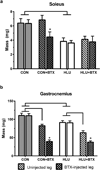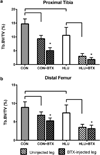Combined effects of botulinum toxin injection and hind limb unloading on bone and muscle
- PMID: 24240478
- PMCID: PMC3921683
- DOI: 10.1007/s00223-013-9814-7
Combined effects of botulinum toxin injection and hind limb unloading on bone and muscle
Abstract
Bone receives mechanical stimulation from two primary sources, muscle contractions and external gravitational loading; but the relative contribution of each source to skeletal health is not fully understood. Understanding the most effective loading for maintaining bone health has important clinical implications for prescribing physical activity for the treatment or prevention of osteoporosis. Therefore, we investigated the relative effects of muscle paralysis and reduced gravitational loading on changes in muscle mass, bone mineral density, and microarchitecture. Adult female C57Bl/6J mice (n = 10/group) underwent one of the following: unilateral botulinum toxin (BTX) injection of the hind limb, hind limb unloading (HLU), both unilateral BTX injection and HLU, or no intervention. BTX and HLU each led to significant muscle and bone loss. The effect of BTX was diminished when combined with HLU, though generally the leg that received the combined intervention (HLU+BTX) had the most detrimental changes in bone and muscle. We found an indirect effect of BTX affecting the uninjected (contralateral) leg that led to significant decreases in bone mineral density and deficits in muscle mass and bone architecture relative to the untreated controls; the magnitude of this indirect BTX effect was comparable to the direct effect of BTX treatment and HLU. Thus, while it was difficult to definitively conclude whether muscle force or external gravitational loading contributes more to bone maintenance, it appears that BTX-induced muscle paralysis is more detrimental to muscle and bone than HLU.
Conflict of interest statement
The authors have stated that they have no conflict of interest.
Figures







Similar articles
-
Muscle changes can account for bone loss after botulinum toxin injection.Calcif Tissue Int. 2010 Dec;87(6):541-9. doi: 10.1007/s00223-010-9428-2. Epub 2010 Oct 22. Calcif Tissue Int. 2010. PMID: 20967431
-
Muscle and bone follow similar temporal patterns of recovery from muscle-induced disuse due to botulinum toxin injection.Bone. 2010 Jan;46(1):24-31. doi: 10.1016/j.bone.2009.10.016. Epub 2009 Oct 21. Bone. 2010. PMID: 19853070
-
Pantoprazole, a proton pump inhibitor, does not prevent botulinum toxin induced disuse osteopenia in mice.J Musculoskelet Neuronal Interact. 2017 Sep 1;17(3):162-175. J Musculoskelet Neuronal Interact. 2017. PMID: 28860418 Free PMC article.
-
Neglecting Bone Health: A Critical Gap in Management of Muscle Spasticity with Botulinum Toxin in Spinal Cord Injury.J Musculoskelet Neuronal Interact. 2024 Sep 1;24(3):318-324. J Musculoskelet Neuronal Interact. 2024. PMID: 39219330 Free PMC article. Review.
-
Botulinum Toxin A and Osteosarcopenia in Experimental Animals: A Scoping Review.Toxins (Basel). 2021 Mar 14;13(3):213. doi: 10.3390/toxins13030213. Toxins (Basel). 2021. PMID: 33799488 Free PMC article.
Cited by
-
Osteocyte Apoptosis Caused by Hindlimb Unloading is Required to Trigger Osteocyte RANKL Production and Subsequent Resorption of Cortical and Trabecular Bone in Mice Femurs.J Bone Miner Res. 2016 Jul;31(7):1356-65. doi: 10.1002/jbmr.2807. Epub 2016 Mar 22. J Bone Miner Res. 2016. PMID: 26852281 Free PMC article.
-
Update on the effects of microgravity on the musculoskeletal system.NPJ Microgravity. 2021 Jul 23;7(1):28. doi: 10.1038/s41526-021-00158-4. NPJ Microgravity. 2021. PMID: 34301942 Free PMC article. Review.
-
Immobilization induced osteopenia is strain specific in mice.Bone Rep. 2015 Apr 17;2:59-67. doi: 10.1016/j.bonr.2015.04.001. eCollection 2015 Jun. Bone Rep. 2015. PMID: 28377955 Free PMC article.
-
Dose-dependent skeletal deficits due to varied reductions in mechanical loading in rats.NPJ Microgravity. 2020 May 18;6:15. doi: 10.1038/s41526-020-0105-0. eCollection 2020. NPJ Microgravity. 2020. PMID: 32435691 Free PMC article.
-
Osseointegration of Titanium Implants in a Botox-Induced Muscle Paralysis Rat Model Is Sensitive to Surface Topography and Semaphorin 3A Treatment.Biomimetics (Basel). 2023 Feb 25;8(1):93. doi: 10.3390/biomimetics8010093. Biomimetics (Basel). 2023. PMID: 36975323 Free PMC article.
References
-
- Judex S, Carlson KJ. Is bone's response to mechanical signals dominated by gravitational loading? Med Sci Sports Exerc. 2009;41:2037–2043. - PubMed
-
- Frost HM. On our age-related bone loss: insights from a new paradigm. J Bone Miner Res. 1997;12:1539–1546. - PubMed
-
- Morey-Holton E, Globus RK, Kaplansky A, Durnova G. The hindlimb unloading rat model: literature overview, technique update and comparison with space flight data. Adv Space Biol Med. 2005;10:7–40. - PubMed
Publication types
MeSH terms
Substances
Grants and funding
LinkOut - more resources
Full Text Sources
Other Literature Sources

